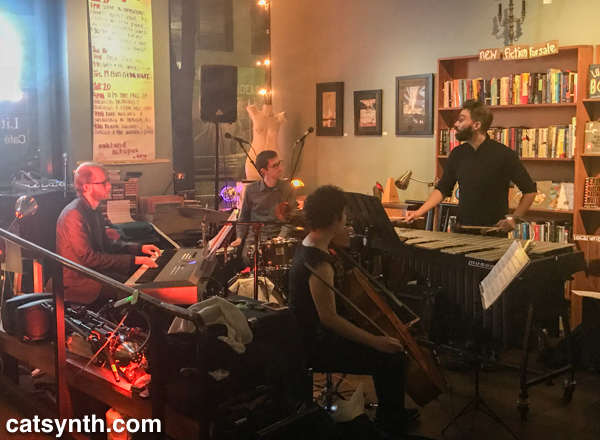
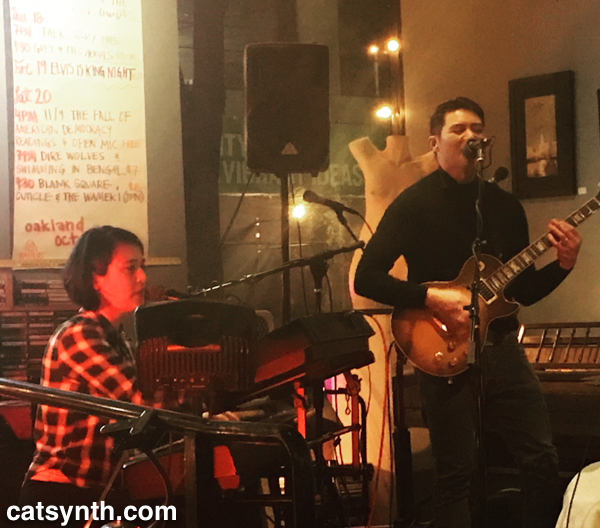



Our first music report of the year features the final show we saw in 2017. Scott Amendola assembled a cast of seasoned improvisers for a concert at Slim’s in San Francisco that took us on quite a journey over two full-length sets. It was the subject of our last CatSynth TV.
As one can hear in the video, there were a variety of textures throughout the two sets. My favorites were the forceful rhythmic sections, some of which came at the very start of the performance. There were also quite a few “operatic” segments that featured the voice of Pamela Z, who was also manipulating samples through various electronic processes. Aurora Josephson’s vocals provided a counterpoint with different timbres and style.
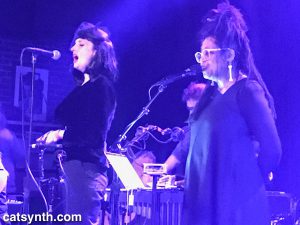
The ensemble includes three electric guitars (Henry Kaiser, John Schott, and Fred Frith) and three percussionists (Jordan Glenn, Robert Lopez, William Winant). As we have often remarked, doubling and tripling of such powerful instruments can be treacherous, especially in an improvised setting. But it worked here, as everyone had a distinct sound, and the good sense to always listen and lay out when appropriate. In fact, to my ears the music, especially during the more operatic less rhythmic sections, was dominated by the concert string section, consisting of Christina Stanley and Alisa Rose on violin, Crystal Pascucci on cello, Zach Ostroff on string bass, and Soo-Yeon Lyuh on haegeum. At various points, Mark Clifford cut through the harmonies and timbres on the ensemble with frenetic solos on vibraphone.
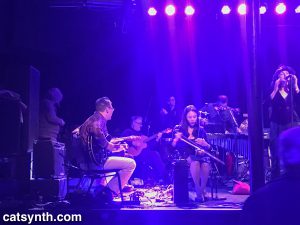
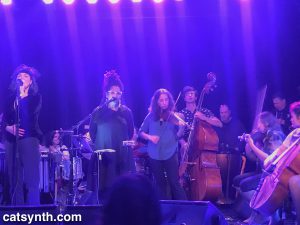
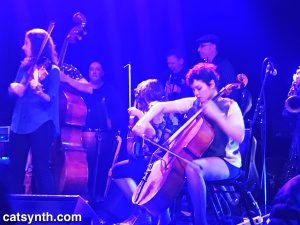
The ensemble was rounded out with the wind section, which included the entire Rova Saxophone Quartet: Bruce Ackley, Larry Ochs, Steve Adams, and Jon Raskin. I felt like I didn’t hear as much of a distinct voice from the saxophones as I did from the other sections, but that was perhaps because they blended with the violins and cello.
In all, it was a fine night of music to wrap up the year. As we often do at Slim’s, we enjoyed the concert from the balcony over dinner and drinks, but we also had the chance to mingle with our many friends in the ensemble and the audience. We look forward to more music from everyone in their own projects in 2018.
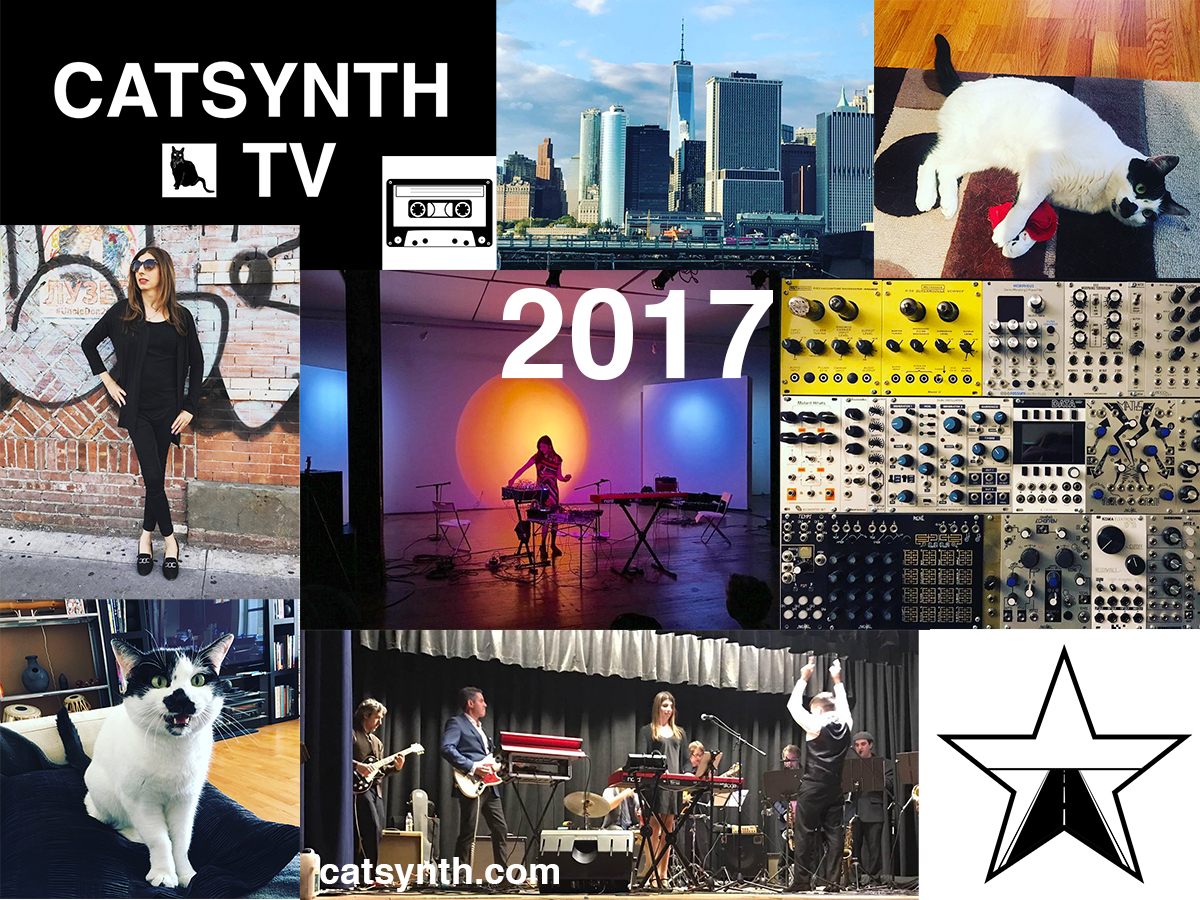
Once again, it is time for our end-of-year collage and review. So many images to choose from in such a busy 2017 that took us in so many directions at once, both outward and inward.
At the end of 2016, I was still reeling from the loss of Luna and the election. But I did welcome Sam Sam into my life and also promised myself that I would prosper and thrive in the new terrifying Trump era. And we did, focusing on moving forward with the things from 2016 that did go well. Lots of new music as a solo performer, with my new band CDP, and with Vacuum Tree Head. There are now three CatSynth-branded apps for both iOS and Android, and a fourth on the way. We launched CatSynth TV, with 22 videos under our belt since October. And Sam Sam has blossomed into a sassy and thoroughly spoiled cat whom we love dearly.
If there is a word of caution on the personal and professional fronts, it is perhaps that 2017 was too much. After a strong first half of the year through July, I scaled back on live performance to focus on other priorities. I regret that, but it was also the reality of the many things going on. I wish the apps, blog, and video channels were progressing faster, but it’s as fast as we can go with our myriad other responsibilities. The last couple months, while still rich with experience, have been an exercise in paring back and trying to focus on the highest priorities; and also focus on health, self-care, and well being. These are all very challenging, but I’m grateful to have the help of loved ones.
We cannot ignore the fact that our rebound in 2017 after two difficult years took place amidst a dark pall over the country and world. Many friends have suffered amidst the monumental forces of hurricanes, flooding, fires, and human foolishness. The latter is most visible in the face of the current regime that continues to embarrass and threaten us. These are things we have to be vigilant about as we move in 2018. I do feel personally in the cross-hairs on multiple fronts, so I hope we can continue to survive and prosper as well as we did in 2017, and maybe at the end of 2018 we will look back and saw how the world became at least a slightly better place.
It is also interesting to look back to our end-of-year post from 2007, ten years ago. It was a dark, cold time amidst major life changes – I couldn’t have imagined then what life would be like now. Will we feel the same way in 2027? And will there still be a CatSynth then? Only time will tell…
Today we look back at the December show at the Starline Social Club featuring the Fred Frith Trio, IMA, and Watkins / Peacock. It was the subject of a recent episode of CatSynth TV.
In addition to giving a great interview, Zachary Watkins performed a great set with collaborator Ross Peacock, featuring a large array of electronic gear, with interesting rhythms, harmonies, and timbres throughout. The largely improvised set included several patterns and patches from Watkins as well as solo work by Peacock on a vintage Korg MS-20.
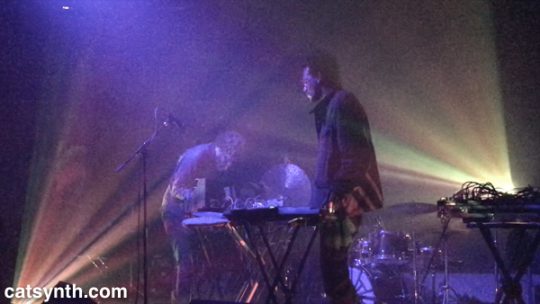
IMA, the duo of Nava Dunkelman and Jeanie Aprille Tang (aka Amma Ateria) provided a very different sound and style combining percussion and electronics.
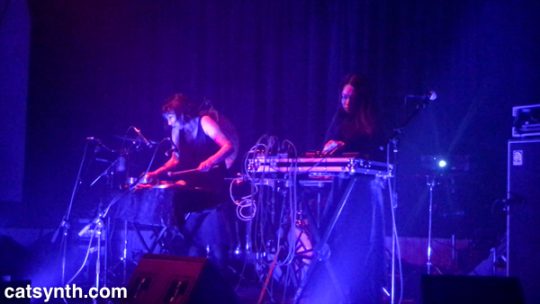
The timbres of Nava Dunkelman’s percussion and Tang’s electronics complement each other, with the electronics weaving between the frequency ranges and timbres of the percussion. This worked especially well with the metallic sounds. Having played together as a unit for a while now, IMA’s improvised sounds have a tight structure and narrative quality.
Then it was time for the Fred Frith Trio to take the stage. In addition to Frith, the trio features Jason Hoopes on bass and Jordan Glenn on drums.
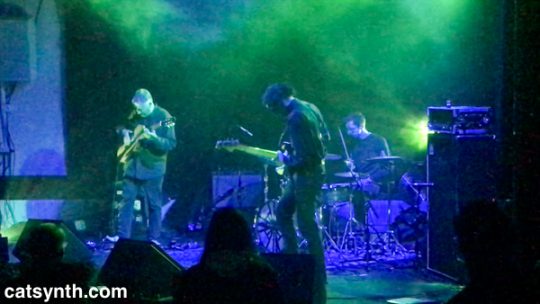
Like IMA, the trio locked in even in more free-form improvised sections to maintain a rhythmic and virtuosic quality. They have developed a musical language among the three of them that allows them to converse and also listen during “monologues”, like Frith’s solos or Hoopes’ dramatic bass patterns.
We had a great time at this show – the Starline is a good place to see live music. The stage lighting was almost a performer in its own right, constantly changing and adapting to the music. The fog could have been a bit lighter, though.
Today we look back at the recent concert by John McLaughlin and Jimmy Herring at the Warfield in San Francisco. We at CatSynth were fortunate to have been in attendance for this event.

It was billed at as “The Meeting of the Spirits Tour”, and the two groups, officially Jimmy Herring & The Invisible Whip and John McLaughlin & The Fourth Dimension were far more connected musically than in many bills. This connection was established with the first song from Herring’s set, the Miles Davis composition “John McLaughlin.” There were other covers in the set as well, including a tune from The Allman Brothers Band and another Miles Davis tune “Black Satin.” But there were also several of Herring’s originals, including “Matt’s Funk” which I quite enjoyed. It was an extremely tight funky number, which harkened back both to the 1970s and to Herring’s own musical heritage from the jam band era of the 1980s and 1990s.
After a break, the maestro himself took the stage with the other members of The Fourth Dimension.

[John McLaughlin]
They played selections from their recent album Black Light but then launched into classics from Mahavishnu Orchestra to the delight of us at CatSynth and many others in the audience. In true “Mahavishnu” style, these were extended jams with everyone taking turns providing solos and rhythm-section work. And this led up to “Meeting of the Spirits” and bringing Herring and the members of The Invisible Whip back on stage for an extended third set.

[Jimmy Herring & The Invisible Whip join John McLaughlin and The Fourth Dimension]
A “supergroup” set like this can be treacherous, even with master musicians. This is especially true when combining multiple bassists and drummers. But it worked, and worked well, as the two bands blended together into a Mahavishnu tribute. And the doubled bass and drums locked in together into something reminiscent of a live King Crimson set. (See our review of King Crimson at the Fox in Oakland from earlier this year.). I suspect this collaboration got better over time and coming near the end of the tour we probably got to hear one of the best versions.
Our latest CatSynth TV documents yesterday’s edition of inWooble, a monthly synthesizer meetup and jam session at LinkedIn’s offices in downtown San Francisco. I had the opportunity to join this time, and had a good time performing with everyone – I particularly enjoyed the time where we were rhythmically together or forming complex contrapuntal textures across the six modular-synthesizer setups. And the views of downtown SF out the window were pretty cool, too.
Hosts:
Franck Martin
Juan Rosales
Bryan Levay
Participants:
M.0 (Maurice Jackson)
Amanda Chaudhary
Chris Otchy
The Facebook live stream from the event can be found https://www.facebook.com/franck.martin.music/videos/1921164038148996/
Greetings, and happy third night of Hannukah! Today we look at the Soundtracks exhibition currently on display at the San Francisco Museum of Modern Art (SFMOMA) through the end of the year. It is also the subject of our most recent CatSynth TV episode.
The exhibition explores the intersection of sound, visualization, and space, and features over 20 artists. There are a variety of interpretations and methods of making sound, from acoustic to mechanical to electronic. None of the sound installations are overpowering, but many do arrest ones attention. Upon arriving at the 7th floor for the exhibition, one is created by Anri Sala’s Moth in B-Flat, which features a mechanically triggered snare drum hanging inverted from the ceiling.

[Anri Sala. Moth in B-Flat (2015_]
The electro-mechanical theme continues with O Grivo’s Cantilena, which includes several motorized sound-making sculptures primary made of wood.

[O Grivo. Cantilena (2017)]
These were fun to watch, and I found myself wanting to make one myself (we shall see if that actually occurs).
Simplicity reigned in Céleste Boursier-Mougenot’s clinamen v.3. A large shallow pool of water contained floating ceramic bowls. The frequent collisions of the bowls created a music that was very captivating.

[Céleste Boursier-Mougenot. clinamen v.3 (2012–ongoing)]
This piece was deeply calming, and I found myself zeroing in on groups of bowls as they collided and separated to form rhythms and harmonies.
Ambient soundscapes were also the heart of an installation by Brian Eno, New Urban Spaces Series #4: “Compact Forest Proposal,”, with a darker tone and more complex technology.

[Brian Eno.New Urban Spaces Series #4: “Compact Forest Proposal” (2001)]
One is free to wander the darkened space amidst the moving columns of LED lights. Every once in a while, the light increases and one gets glimpses of shadowy figures on the wall. The sounds ranged from small percussive synth hits to trumpets to electronic noise.
Electronic noise was also at the heart of Christina Kubisch’s installation Cloud. Kubish’s work explores sonification of data and electricity. The mass of red electrical wires emits electromagnetic radiation, which was interpreted as sound using customized headphone devices.

[Christina Kubisch. Cloud (2011/2017)]
Of all the installations, this was the among the most challenging to take in sensually or to document. I love the concept, and I think it really needs an extended period of time alone to experience fully.
From the large to the small. We had fun with Sphere Packing by Rafael Lozano-Hemmer, which featured several spherical speaker arrays made from those ubiquitous white Apple earbuds.

[Rafael Lozano-Hemmer. Sphere Packing (2013 and 2014)]
Each was playing a different selection of classical music from the 18th, 19th and 20th centuries, rearranged and diffused asynchronously through the speakers. Lozano-Hemmer also had an installation Last Breath that included a recording of breathing by the late Pauline Oliveros.
We conclude with another project visualized as a sphere. Lyota Yagi’s Sound sphere featured a sphere wrapped in cassette tape that freely rotated and revolved. Customized pickups rendered the sound from the tape, which is chopped, looped and distorted based on the chaotic motion of the sphere.

[Lyota Yagi. Sound Sphere (2011)]
All of these pieces were inspiring for my own work, as I want to do more sound installation in the coming year. There were more in the main the exhibit and spread around the museum, but beyond what I can cover in this article. We do encourage you to check out our video to hear how some of these pieces sound. And if you are in the Bay Area, we strongly recommend checking the exhibition out before it closes on January 1, 2018.
Recently, John Lee, the creator of bayimproviser.com donated a portion of his extensive record collection to Outsound. And our friends at VAMP are helping us sell them to fund our continuing mission of promoting new music in the Bay Area and beyond. To launch this effort, Outsound held a benefit concert at VAMP on December 1.
I performed a solo set with my trusty Nord Stage EX, modular synth, and Casio SK-1.

As with most of my current solo performances, I try to combine both idiomatic jazz and funk elements with more experimental electronics. I opened with White Wine (instrumental) with the extended solo section morphing into a more free-form electro-acoustic improvisation that also included the garrahand drum. It moved from sections of disco and bossa nova rhythms to noise to complex harmonies from the drum and Make Noise Echopon module. It was a fun set with an appreciative audience of both attendees and record-store patrons.

After my set, Tri-Cornered Tent Show took stage. Anchored by bandleader Philip Everett on clarinet and electronics and Ray Schaeffer on bass, the band explored a variety of sounds and styles from noisy electronics and percussion to R&B grooves to psychedelic serenades featuring Valentina O on vocals. Anthony Flores rounded out the band on drums.

It was interesting to see how both sets explored the intersection of avant-garde electronic and acoustic sounds with more familiar idioms. Soul, funk, and R&B were present in both sets, but then we each veered off in different directions. Between us, we might have covered many of the genres in VAMP’s record bins!
It was a fine night of music and fellowship, and it’s great to see an independent (and idiosyncratic) store like VAMP flourishing in downtown Oakland. You can find out more about them here. And please visit Outsound’s website to find out about upcoming programs and how you can help support our work bring new music to our community.
Today we look back at the recent show featuring Song & Dance Trio and Lithuanian sound-and-performance artist Arma Agharta at the Luggage Store Gallery in San Francisco. It was the subject of a recent episode of CatSynth TV.
I have seen the members of Song & Dance Trio, Karl Evangelista (guitar), Jordan Glenn (drums) and Cory Wright (baritone saxophone) many times before in many musical contexts, but this was the first time I saw them as a trio. As one can hear in the video, they mixed complex virtuosic avant-garde performance with familiar jazz idioms. And they made it work. There was a strong rhythmic sense throughout the set, with the musicians moving freely between a relaxed shuffle and frenetic staccato runs. The familiar jazz figures sprinkled throughout were fun, but the more experimental interludes were a palette cleanser that made the grooves stand out more strongly.

[Song & Dance Trio (Evangelista, Glenn, Wright)]
Next up was a solo performance by Arma Agharta, a Lithuanian sound-performance-artist who was kicking off the west-coast swing of his United States tour. I didn’t know quite what to expect, even after looking at his interesting setup with a mixture of sound-making objects and electronic instruments.

[Arma Agharta’s colorful electro-acoustic rig]
And then he took the stage wearing a large pointed had and colorful robe. Things started quietly but very quickly turned to a loud, frenzy of sound, movement, and vocals.


[Calm and anything-but-calm moments with Arma Agharta]
This was one of the most physically and sonically intense solo performances I have seen in a while, and the energy was nonstop for most of the duration, with just a few ebbs and pauses. An endurance test for performer and audience alike. I haven’t heard anything quite like it, and it is hard to do justice either in written or video form. The intense sounds were from many layers of electronics, including recorded sounds played at high volume along with Arma Agharta’s own powerful voice howling, bellowing, and other vocalizations.
It was interesting to see such different performances in the same show and to assemble them into a single 3-minute video. But it worked both live and recorded. We wish Arma Agharta well on his next tour (last we saw he was in Turkey) and hope to hear more from him. We, of course, will continue to follow Evangelista, Glenn, and Wright on their musical adventures here in the Bay Area.
Today we look back at the recent performance by Pet the Tiger invented instrument collective in Golden Gate Park. It was part of a series hosted by Dan Gottwald featuring invented-instrument performances in the tunnel near the Conservatory of Flowers. You can see and hear excerpts from the concert this CatSynth TV video.
The centerpiece of the performance was the harmonic-series gamelan, a set of instruments that employ tuning based exclusively on the harmonic series. This leads to just-intonation relationships among pitches, but not necessarily those of conventional Western twelve-tone music. The results are haunting and exquisite. This is especially true of the 5-octave metallophone demonstrated by David Samas in the video, and played by Samas and others in the concert.

There was also a large kalimba-like instrument performed primarily by Samas and Derek Drudge, and a large instrument created and played by Bart Hopkin.

In addition to the metallophones, there were various wind instruments. Peter Whitehead played an instrument that resembled a longitudinal bass flute, and whirling tubes, all of which also conformed to the harmonic series.

There was also a stringed instrument performed by Ian Saxton.
Harmonic series relationships are well known to be very pleasant to the ear, and there was an overall pleasing tone to the music, amplified by the acoustic properties of the tunnel, the lighting and the fellowship of performers and audience. In addition to the long meditative pieces, there were sections combining music with anxious dystopian poetry, and even a rendition of George Harrison’s “Within You Without You” from Sgt. Pepper’s Lonely Hearts Club Band.
Overall, it was a lovely and poignant evening, with the light show from the Conservatory of Flowers in the distance and a warm friendly atmosphere in the tunnel that mitigated the approaching chill of the night in Golden Gate Park. The series is over for the season, but we do expect to hear more of Pet the Tiger and these inventor-musicians in the near future.